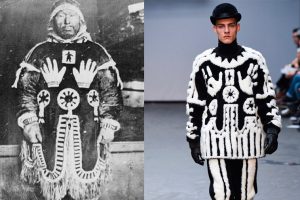As a (unpublished) writer, I have a funny relationship with the concept of Intellectual Property.
On the one hand, I very much identify with the idea that there is nothing new under the sun and that we are influenced by everything and everyone we cross paths with. As a writer, I can cite Joan Kane, Shakespeare, and T. S. Eliot as influences without worrying about being accused of stealing their ideas. I can write a poem in the villanelle form without having to pay a royalty to whoever created this form
I also understand and support the desire for progress and the sharing of ideas for the betterment of humanity. Open software allows us to create and continue to create online content that is accessible to others. Leaving such works open and available to all leads to innovation.
But, there is the idea that a person who puts work into the creation of something, whether it is physical property or intellectual property, should stand to profit from their creation in some way. An author sells copies of their books, their intellectual property. Someone who builds a house either gets to sell it, or live in it.
There are many other factors that go into this. I think that one of the functions that IP laws serve is to protect creators from entities that would take advantage of the creation of others for their own profit, rather than for the benefit of all.
In this blog, I will focus one specific example of this.
For example, in November of 2015, a UK clothing designer called KTZ received backlash for a particular sweater in their line, shown on the right in the picture below.

The man on the left was an Inuit shaman from Iglulik, Nunavut, named Awa. The sweater retailed for around $845. There can be no doubt that the inspiration for this garment came from Awa’s design, it is very close to an exact copy. Ok, fashion designers take inspiration from many sources. So what’s the big deal? Well, according to a CBC article, the design was used without Awa’s descendant’s permission or awareness, which caused outrage from the family members. Furthermore, this particular design was not just a fashion choice made by Awa. He didn’t just decide to create a new fashion trend. Awa was a shaman, a religious leader in his community. According to great-granddaughter, Salome Awa, “[Awa] had a vision of being drowned and created the garment with the help of his family to protect him” (CBC). This garment was designed and produced for a spiritual purpose.
KTZ’s sweater design, as far as I could tell from research, was not the result of any sort of collaboration with the Awa family or the community they are from. Although a Vogue overview of that particular line cites the inspiration as coming from Inuit culture, that the designs (which also were inspired by A Clockwork Orange) were meant to evoke “droogs in the making—suburban kids at loose ends—being sent to rehab in the Arctic.”
The family was not offered any monetary compensation, although KTZ did issue an apology and pulled the garment from its line and out of stores.
This is not the first time such an appropriation has happened to an indigenous community. Within the past forty years, various indigenous communities from around the world have made various declarations supporting and protecting their intellectual property rights. In 2007, the UN adopted a Declaration on the Rights of Indigenous People. Article 11, Section 1 reads
Indigenous peoples have the right to practise and revitalize their cultural traditions and customs. This includes the right to maintain, protect and develop the past, present and future manifestations of their cultures, such as archaeological and historical sites, artefacts, designs, ceremonies, technologies and visual and performing arts and literature.
IP’s true intention is not only to protect the intellectual work of any person, it is also to protect the creator and their work from the power structures that would take advantage of them. Was it within the legal rights of KTZ to appropriate Awa’s design? Ummm…sure. After all, the design wasn’t patented according to Western law, and being from the early 20th century, if it were it would probably fall under public domain by now. But does that mean it was ethical? No. The historical trauma felt by many indigenous peoples, including the Inuit of Canada, makes the appropriation by KTZ especially unethical. Indigenous peoples have, for centuries, been the object of exoticism and abuse. Desired for their strange and intriguing arts but also despised and mistreated for their difference…and for their resources. This appropriation of Awa’s design perpetuates that abuse.
Learn about Awa’s story from these titles:
Across Arctic America by Knud Rasmussen (chapters 3 and 9)
Northern Voices: Inuit Writing in English, Ed. Penny Petrone
The Journals of Knud Rasmussen, dir. by Zacharias Kunuk and Norman Cohn
Sources:
KTZ fashion under fire for using Inuit design without family’s consent
KTZ Apologizes for Plagiarism of Canadian Inuit Indigenous Design
U.K. fashion house pulls copied Inuit design, here’s their apology
Indigenous Intellectual Property (Wikipedia)
United Nations Declaration on the Rights of Indigenous Peoples
